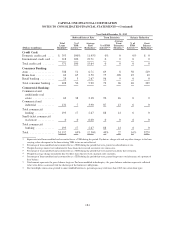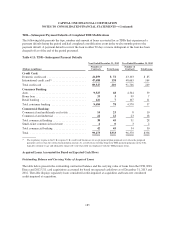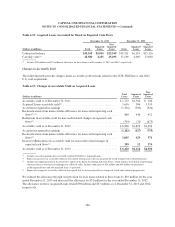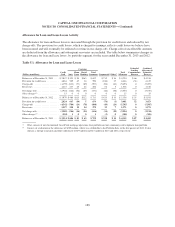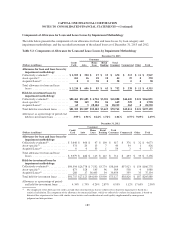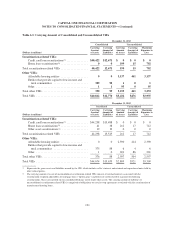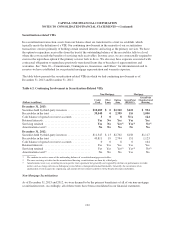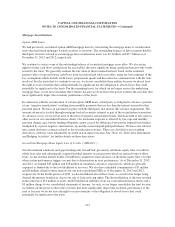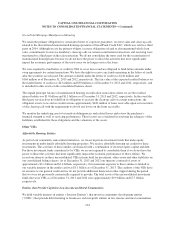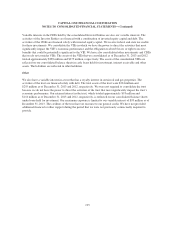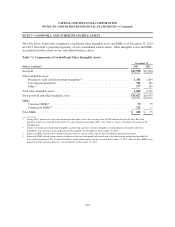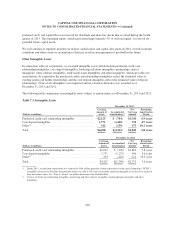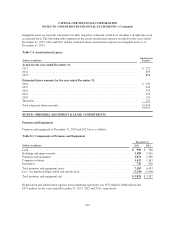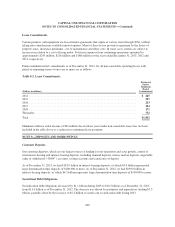Capital One 2013 Annual Report Download - page 213
Download and view the complete annual report
Please find page 213 of the 2013 Capital One annual report below. You can navigate through the pages in the report by either clicking on the pages listed below, or by using the keyword search tool below to find specific information within the annual report.CAPITAL ONE FINANCIAL CORPORATION
NOTES TO CONSOLIDATED FINANCIAL STATEMENTS—(Continued)
Mortgage Securitizations
Option-ARM Loans
We had previously securitized option-ARM mortgage loans by transferring the mortgage loans to securitization
trusts that had issued mortgage-backed securities to investors. The outstanding balance of debt securities held by
third-party investors related to our mortgage loan securitization trusts was $2.3 billion and $2.7 billion as of
December 31, 2013 and 2012, respectively.
We continue to service some of the outstanding balance of securitized mortgage receivables. We also retain
rights to future cash flows arising from the receivables, the most significant being certificated interest-only bonds
issued by the trusts. We generally estimate the fair value of these retained interests based on the estimated
present value of expected future cash flows from securitized and sold receivables, using our best estimates of the
key assumptions which include credit losses, prepayment speeds and discount rates commensurate with the risks
involved. For the trusts that we continue to service, we do not consolidate these entities because we do not have
the right to receive benefits that could potentially be significant nor the obligation to absorb losses that could
potentially be significant to the trusts. For the remaining trusts, for which we no longer service the underlying
mortgage loans, we do not consolidate these entities because we do not have the power to direct the activities that
most significantly impact the economic performance of the trusts.
In connection with the securitization of certain option-ARM loans, a third party is obligated to advance a portion
of any “negative amortization” resulting from monthly payments that are less than the interest accrued for that
payment period. We have an agreement in place with the third party that mirrors this advance requirement. The
amount advanced is tracked through mortgage-backed securities retained as part of the securitization transaction.
As advances occur, we record an asset in the form of negative amortization bonds, which are held at fair value in
other assets on our consolidated balance sheets. Our maximum exposure is affected by rate caps and monthly
payment change caps, but the funding obligation cannot exceed the difference between the original loan balance
multiplied by a preset negative amortization cap and the current unpaid principal balance. We have also entered
into certain derivative contracts related to the securitization activities. These are classified as free standing
derivatives, with fair value adjustments recorded in non-interest income. See “Note 10—Derivative Instruments
and Hedging Activities” for further details on these derivatives.
GreenPoint Mortgage Home Equity Line of Credits (“HELOCs”)
Our discontinued wholesale mortgage banking unit, GreenPoint, previously sold home equity lines of credit in
whole loan sales and subsequently acquired residual interests in certain trusts which securitized some of those
loans. As the residual interest holder, GreenPoint is required to fund advances on the home equity lines of credit
when certain performance triggers are met due to deterioration in asset performance. As of December 31, 2013
and 2012, we funded $29 million and $28 million in cumulative advances, respectively, which are generally
expensed as funded due to the low likelihood of recovery. We also have unfunded commitments of $7 million
and $8 million related to those interests for our non-consolidated VIEs as of December 31, 2013 and 2012,
respectively. In the fourth quarter of 2013, we deconsolidated one of these trusts as a result of no longer being
deemed the primary beneficiary due to our sale of loan servicing rights. The deconsolidation of the trust resulted
in the removal of $33 million of assets and $30 million in liabilities from our consolidated balance sheets and a
$3 million charge to our consolidated statements of income. As such, we no longer consolidate the trust because
we either lack the power to direct the activities that most significantly impact the economic performance of the
trust or because we do not have the right to receive benefits of the obligation to absorb losses that could
potentially be significant to the trusts.
193



